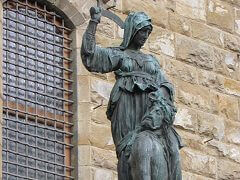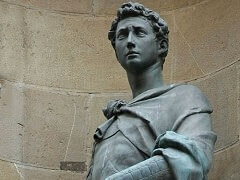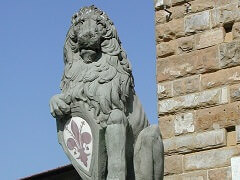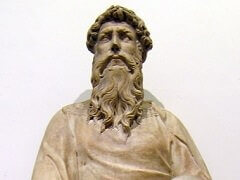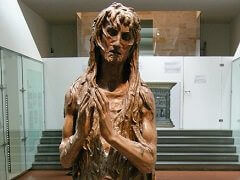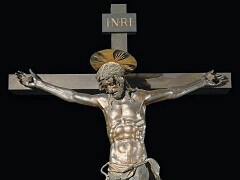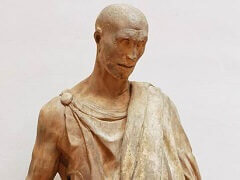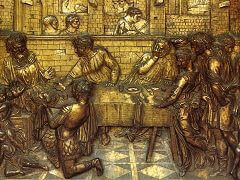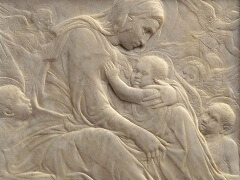10 Facts you Might Not Know about David by Donatello

Donatello created two statues depicting David during his career. His very first commissioned work was a marble rendition of the biblical hero created around 1408. It was a fairly traditional piece that Donatello created in his early twenties, and did not feature what would become his trademark naturalism. Its possible that his study of David's character could have informed his later and much more popular bronze statue of David and the Head of Goliath.
The second David was a commission from the Medici family in the 1430s. It was the first freestanding bronze statue of the Renaissance. The hero is pictured after defeating Goliath. He is nude except for his boots and a hat topped with a laurel. Donatello borrowed from ancient Roman culture when including the laurel; it is a symbol of victory.
Unlike Michelangelo's David, Donatello's David is extremely realistic and a prime example of Renaissance naturalism. His body appears lithe as he stands with one foot atop Goliath's decapitated head. His small frame and almost effeminate disposition imply that his victory is due to God's assistance. He holds a sword which looks huge in proportion to his body and smiles proudly.
Donatello's David was also the first male nude statue since classical antiquity. It is strikingly different from classical depictions of male nudes. To this day it remains a groundbreaking achievement, and a testament to Donatello's mastery in bronze-work. It is housed in the Bargello museum in Florence.
10 Facts That You Don't Know About David by Donatello
1. Donatello's original marble David statue, sculpted during the first decade of the 15th century, has several younger siblings, including one sculpted by the artist himself approximately 40 years later. Italian artist Verrocchio sculpted a version of David in 1475 while Michelangelo created the most famous depiction of the youth around 1501. Lesser-known David statues include a bronze by Bellano in the late 15th century and Bernini's marble David in the 17th century.
2. The Renaissance David statues by Donatello, Verrocchio and Michelangelo remain in Florence, where they were created, to the present day. The city had adopted David as a symbol of triumph over larger, more powerful foes early in the era. The Bellano is now housed at the Metropolitan Museum of Art in New York City while the Bernini version is located at the Galleria Borghese in Rome.
3. Donatello's later David was the first freestanding bronze cast statue of the Renaissance era as well as the first nude sculpture of a male since the classical sculptures of ancient Greece.
4. The bronze statue was controversial during the Renaissance and thereafter due to the sexual connotations some experts took note of, such as the wing from the giant's helmet which rests along the length of David's leg.
5. While Donatello's first David and his bronze David are around six and five feet tall respectively, Michelangelo's version is more than twice their size at a towering 13 feet, five inches. Additionally, Donatello shows David directly following his triumph over the giant while the Michelangelo's David depicts David prior to the battle.
6. Donatello's two statues of David illustrate the development of his style and vision from the heavy Gothic influence of his youth, characterized by ornament and grace, to a more naturalistic style of his later years that was less idealized and more realistic.
7. Although the original bronze David by Donatello remains in Florence, several copies are on display in locations around the world, including a rendition in plaster in London's Victoria and Albert Museum, a marble replica in the Royal Botanic Gardens, and a plaster version in Connecticut's Slater Museum.
8. Donatello's bronze David first went on display in the courtyard of the Medici family in Florence, who many believe originally commissioned it. After the family lost favor in 1496, officials relocated the statue to the Palazza Vecchio's courtyard, and afterwards the David found a permanent home in Florence's Bargello Museum.
9. The differences between the artist's first David sculpture and the second attest to the evolution of Donatello's humanist perspective, which is emblematic of Renaissance enlightenment. As such, Donatello's bronze David illustrates the merger of classical influences with such features as nudity, and realism, such as the artist's choice to show David as the undeveloped youth of the Bible story rather than a classic hero.
10. Prior to the renewed interest in David as an artistic subject during the Renaissance, artists typically presented the biblical figure as the king he would later become rather than the boy who triumphed over Goliath.


